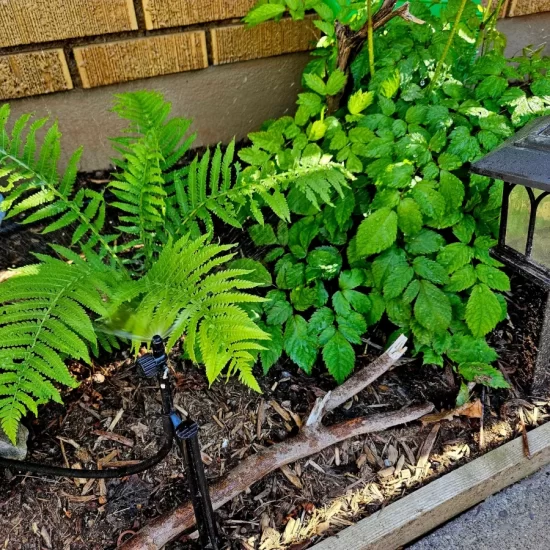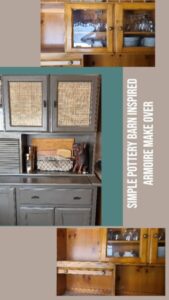
Save water grow better was the idea behind changing out my old soaker hoses for an irrigation system. I have struggled with water going into my basement. I had put sand and pebbles in my window wells to help with that situation. However, dealing with that I would also struggled with under watering just in fear of water leaking into the basement. This would be a strain on plants that needed consistently hydration.
To solve this problem I installed soaker hoses with timers and that worked pretty well. The hoses were getting worn and some mineral build up in a few places and I didn’t believe that some plants were getting enough water with this method.
I decided that consistent hydration is important for my garden and new plants that I have been planting over the past few year. I believed that a drip irrigation system would upgrade my gardening ability. Not to mention, that it would still work with my hose and timer setup.
As I looked into this type of irrigation I was impressed with the versatility of this system. It seemed simple yet a powerful system delivers water directly to the roots of your plants—right where most of them need it the most. Some like overhead misting better and this system can do that as well. This is what I need for my ferns that I have tried to get to grow for the last 3 years (which I have learned a lot of soil in the last few years).
What Is Drip Irrigation?
Drip irrigation is a low-pressure, low-volume watering system that uses a network of tubing, emitters, and valves to slowly release water to the base of plants or spray the plants. Unlike sprinklers that spray water over a wide area, drip systems target specific areas, minimizing waste and maximizing efficiency.
What is it like putting one of these systems together
Irrigation Kit
For my system, I used the DIG Raised Bed Garden Drip Irrigation even though my garden beds are not raised they are around my house at this point. These beds are around 3/4 of my house. The only place they are not at is my drive way and RV pad. The decision was based on all of the turns and all of the shoot outs from the 1/2 tubing of the irrigation system. This system is now $45.00 when I purchased it just a few months ago it was $29.00. I got mine at Home Depot but Lowe’s has them as well. You don’t necessarily need a kit it was just less expensive for me.
Two types of tubing and putting it together
It is easy to cut and punch the 1/2 tubing and it is also easy to cut the 1/4 tubing. It is harder to put the little barbers in both the 1/2 and 1/4 tubing. I tried my heat gun, which worked well but it was a pain having to have an electrical cord around the whole house. I eventually went to a lighter which was more convenient. You have to be careful not to melt anything it only takes a bit to make the tubing more pliable. This system doesn’t leak from where the barbers are placed from my experience.
Irrigation fittings
Buttons (emitter dripper)
I have the button sprinklers (Adjustable Multi-Stream Emitter Dripper) which are right at the roots from some of my plants. You can adjust these and they can be installed right by the plants roots.


Button on a pike or (spray jet)
The ferns have the sprinklers on a spike (180-Degree Adjustable Spray Jet on Spike), 180 because I have walkways around some of these areas and I don’t want water on those areas. It is a waste of water and can damage your walkway over time. These sprinklers have some water come out of them, I was quite surprised how far they can spray. They are adjustable which does help to keep the water where you need it.


Sprinkler on a spike (stake)
Button sprayer on a spike (360 Degree 20 Gallons Per Hour Universal Sprayer on Stake) is my favorite for my wildflowers, tulips, lavender and others. I can put this in the middle of my tulips/lilies or whatever you may have and it waters it all. You can add as many as you need of these ones to any area. I enjoy seeing that my plants are watered but the area near my basement is still fairly dry (mainly bone dry at some places).





Yes, you can interchange on the same 1/2 irrigation line depending on what type of flowers or plants or veggies are in your planting area. I have been trying to grow my ferns for 3 years and finally I have them back again.
Porch misters
Porch misters came in very handy with the mister from this brand, they call it Mister with Memory-Flex Tubing. I do use this as well for my porch planter.
Compression fittings
Compression fittings are what I call the screw on fittings for this system. They are actually called 1/2 in. Universal Nutloc Tee. I like these they were easy to secure the 1/2 tubing. In customizing my system, I also used the L fittings and the fittings to link one piece of the 1/2 inch tubing to another piece of 1/2 inch tubing and I will using them again as I am expanding what I have already done. I am very pleased with this type of irrigation system for my planting areas.

Customizing
I have enjoyed being able to customize the system for my needs. One thing I wish I had known before was to make the 1/4 inch tubing longer so that I could have more freedom to move it around based on plants that needed it more. I did this in the corner of my plant bed and I love it. I can move to the tall ornamental grass (that is just a baby), ground cover or the new lavender plant. The 1/4 irrigation line that came with the kit had dip points already in it. This is a great feature as well.



Future expansion
I also like that I can expand this system. In fact, I think I will be adding more irrigation tubing to my new Japanese Garden. I have a water regulator on my short line but I don’t have it on any of the other lines because they expand so far. Besides I live in town which I don’t know if that makes a difference.
I believe this will help with expanding to my new Japanese Garden area along with adding some more shut off valves to direct water to whichever line I choose.
Shut off Value
I currently only have a shut off valve on the porch mister. I don’t want to over water that plant and it is on the porch with a cover so it won’t need water all of the time.


Easy to turn and the 1/2 tubing is attached to my porch (posts or metal terells) with a zip tie. You won’t see it when I cut it because I have a tall dogwood in front of it. I left it long for now so you could see it in the pictures.
I will be posting about my porch re do of these Terrills in a future post as I haven’t finished with that project yet.
Still not sure about one of these inexpensive systems, here is some basic facts about how beneficial they can be for everyone.
Why Drip Irrigation Helps Plants Thrive
Here’s how drip irrigation supports healthier, more beautiful plants:
Water Efficiency: Drip systems use up to 50% less water than traditional methods, making them eco-friendly and cost-effective.
Consistent Moisture: Plants receive a steady supply of water, reducing stress and promoting steady growth.
Healthier Roots: Watering at the soil level encourages deep root development and reduces the risk of fungal diseases.
Fewer Weeds: Since water is delivered only where it’s needed, surrounding weeds don’t get the moisture they crave.
Plants are growing the best that I have seen them
My plant shrubs and bushes are growing at a rapid rate. Some of the my flowering shrubs have never grown this great in 12 years. The only problem with this is I should have trimmed them back last fall and this spring far more than I did. However, in my defense they hadn’t grown this well.
How does your garden grow?




Not too bad, eh.
I will post on social media when they bloom. They are some beautiful plants. It is always good to see your plants grow and knowing you did it with less waste is always a great feeling.
Happy Gardening!
Discover more from Twilight Kaleidoscope
Subscribe to get the latest posts sent to your email.




